Traditional offices are a thing of the past. Long gone are the days of fluorescent lighting, blank white walls, and cramped cubicles that we’d spend every day in, no matter what, 9-to-5. Today, many are working some combination of hybrid or remote work. And when we do go to the office, the space we’re showing up to is way more artful, unique, and high-end than ever before, with fancier amenities.
Because of the pandemic, employers are now more focused on keeping employees healthy and happy, hoping they’ll come to work in person and attract great talent. This has created what’s called the “hospitality-driven workplace,” where offices are getting fancier, taking ideas from hotels, spas, and top-notch gyms. Companies are also buying tools, amenities, and services to make it easier and faster for employees to do their jobs.
But we’re also in a period in which more and more businesses, even those that are profitable, are cutting costs, and that often means drawing the line on amenities. So how do you offer amenities that drive employee engagement and happiness while also keeping costs low? Starting at $450 per month, a Bevi machine is an investment—but an investment that can easily be offset by removing some needless costs from your budget.*
And hey, we get it. At Bevi, we’re trying to invest capital in the right places, too, growing our business and continually working to make our products higher quality and lower cost for our customers and more impactful for the planet. We believe in spending office amenities budgets wisely, avoiding spending on anything that will end up gathering dust or won’t make a noticeable difference to employee happiness, well-being, or productivity.
So here’s how we think about it: what’re you already paying for in the office—and probably shouldn’t—that could easily go towards the cost of a smart water cooler?
With AI-powered technology taking the world by storm and making us more productive, Software-as-a-Service (SaaS) is becoming a larger part of the company budget. A survey by Productiv found that SaaS use steadily grew between 2021 and 2023, and reached an all-time high last year, with organizations using 371 apps on average. This chalks up to a huge company cost of almost $10k per employee.
We all know software technology can be instrumental for working better: it can help us summarize meeting notes, find coding bugs, improve our scheduling system, and write marketing content. But when you can’t keep track of all the subscriptions you’ve signed up for, it can be detrimental, and in the era of recurring payments, the ghosts of subscriptions past will come back to haunt you: the same Productiv study found that 52% of licenses were unutilized. Expenditures on unused, underused, or duplicate SaaS tools represent a huge strain on company budgets, and result in an annual waste of almost $135,000.
If software licensing is under your purview, make sure you’re taking time to review what software tools employees are actually using and train employees so that they are informed about the resources they have at their disposal. By streamlining your SaaS offerings, you can clear up space in the budget for a light and refreshing amenity which doesn’t involve spreadsheets. (Maybe a Bevi machine?)
Think ballpoint pens, notebooks, sweatshirts, T-shirts, baseball caps, tote bags, AirPod cases even — all stamped with your company’s logo. Yes, company merch can be a fun amenity. But how many T-shirts with your company’s logo do your employees really want? Let’s be honest: Most of us have enough T-shirts and tote bags, and are already struggling to clean out our closets.
Often given out at onboarding or around the holidays, company gifts are one tool companies can use to try and bolster employee morale and create a cohesive corporate culture. But the costs often stack up, with companies spending up to $36,000 a year on swag for employees alone, not even counting all the swag purchased for events and customers. And if leftover company merch goes unutilized, it becomes something that takes up space in a company closet or storage unit. Sometimes less really is more when it comes to gifting, and it’s better to invest in an amenity that employees will use on a daily—perhaps even hourly—basis. Maybe something spritzy and hydrating?
As workplaces become more hospitality-driven, many top-tier offices look more like luxury hotels than you might remember. Gone are the days of cubicles and tiny break rooms; now there are “lounges”, quiet zones, and collaborative conference rooms. Every room needs to be furnished accordingly, with a “vibe” and amenities that rivals the comfort you’d get working from home, or the concentration you’d get in a small blank room. This results in a huge cost per person: the San Francisco firm The Space Place estimates that furnishing 10,000 square feet of office space costs companies between $120,000 to $300,000, depending on whether the company chooses standard or high-end fittings.
Comfort is critical, sure, but your conference room table doesn’t need to look like a spaceship to get ideas flying. If your company is ready for a refurbishing, perhaps consider finding someone on your team who’s great at finding deals, and offer them the assignment with a bonus. January and July tend to be good times for company-wide sales, when you can keep your eyes out for special discounts. And the right pieces of second-hand furniture will come at a great discount—reducing the purchase cost by 50% to 80%—while maintaining basically the same functionality.
Many furniture suppliers are happy to offer one-on-one support, and have customer relations representatives happy to help you find the best fit for your budget. If you’re in desperate need of back support, stat, check out this list of ergonomic chairs under $300.
OK, this one isn’t exactly inside the office, but stick with us anyway. In the corporate world, company retreats and fly-outs are a great way to get employees on different teams to break out of their comfort zones, solve problems in new and innovative ways, and build camaraderie. While the idea of whisking away the entire team to a picturesque locale for brainstorming and bonding might sound like the ultimate perk, the costs can quickly spiral into a budgetary black hole. From securing a venue that accommodates both work and leisure to flights, meals, transportation, and team-building activities, the expenses stack up. For instance, flying out a mid-sized team for a weekend retreat could easily run into tens of thousands of dollars, especially if international travel is involved.
Why stop there: with a typical three-day domestic business trip costing around $1,000 per employee, companies are rethinking their vendor meetings and conference plans, finding more cost-effective ways to build networks and understand client challenges.
In comparison, a Bevi smart water cooler in the office is a modest investment that keeps on giving, offering hydration and a small daily delight without the logistical nightmare and hefty price tag of a company-wide retreat. It’s also something that everyone can enjoy, not just one specific team on one specific week. Rather than escape the office, why not make a small investment in making the day-to-day office more exciting?
Nothing says “we’ve made it” like an on-site office gym boasting top-tier equipment. But when you’re talking about the workplace, are machines fit for Olympians really necessary?
With employee health and wellness becoming an increasingly high priority, some workplaces are investing in tools for fitness aficionados, like the Normatec compression tools ($399-$1449) to reduce muscle soreness and the Somadome meditation pod ($14,500) for enhanced mind-body connection. These additional tools are stacked onto the more traditional equipment we already know about, like the Peloton bike – which we love, don’t get us wrong, but comes with a price tag as steep as the mountains you can climb on it ($1,445, plus an All-Access membership which comes at $44/month).
Treadmills, elliptical machines, free weights and tools take up not only a significant amount of space and require cleaning and maintenance, but also a considerable chunk of the budget. More simple measures, like subsidizing employees’ external gym memberships, can be just as effective, and can give your employees more choices.
*Based on a Boston office of 25 employees dispensing about 400, 20 oz. drinks per month.
Now that you’re pondering all those pricey office splurges, a Bevi machine looks like a far simpler investment. Want a quote for your own smart office water dispenser? Complete the form and we’ll be in touch!
In July of 2020, Bevi users reached a notable milestone: They helped save the planet from 200 million plastic bottles. Eliminating the need for plastic bottles and cans is a driving force behind the concept of the Bevi office water dispenser. So much so, that a user can see just how many bottles a particular machine is saving with a counter right in the Bevi touchscreen.
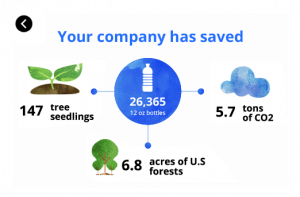
While that may be the most obvious indicator of a positive effect on the environment, there is more behind Bevi’s approach to supporting sustainability in the workplace.
Before you ever grab a beverage at work, a good deal of energy has gone into getting that bottle of water into the office refrigerator. The source for more than half of all bottled water comes from springs and aquifers. Moving all that water to a bottling facility requires energy for pumps and trucks. The bottles it goes into also require significant resources to produce. In a 2007 study, the Pacific Institute found it took the equivalent of approximately 17 million barrels of oil to make all the plastic for bottled water consumed by Americans in 2006. That’s was enough energy to power 1 million vehicles for a year. More recent research at Stanford University in 2018 put the oil consumption number for plastic bottle production at 50 million barrels per year.
But that’s not the only area where fossil fuels come into play. Still more are used in transporting the 50 billion plastic bottles used each year in the U.S. from the manufacturer to the bottling facility.
Finding a better way to do something often requires doing it differently. Point-of-use office water dispensers, such as those from Bevi, connect to an existing water line. From there, the water can be dispensed still, sparkling or flavored right into a glass or reusable beverage tumbler. This not only cuts out the need for plastic bottles and aluminum cans, it eliminates the substantial amount of fuel needed to source, bottle, and transport the water.
While point-of-use water dispensers are certainly more environmentally friendly, there are additional ways to shrink the carbon footprint of your glass of water. By connecting water dispensers to the internet, some manufacturers are able to monitor specific aspects of their machines, such as filter life and supply levels of flavors and CO2. With this information, maintenance and restocking calls can be more accurately scheduled, minimizing the fuel consumption of service vehicles.
In addition to using machine data to schedule flavor and CO2 refills, Bevi has made the service process even greener. Bevi uses flavor boxes made from recyclable materials that can also be easily recycled after use. And the flavor bags, which are made from recyclable #7 plastic, are accepted in some community recycling programs.
There’s nearly universal agreement that staying hydrated throughout the day is important to staying healthy, feeling good, and being more productive. How each of us does that is a personal choice, but we believe a choice that’s good for people as well as the environment is one worth offering. It’s an idea that has caught on with many companies and their employees. You can read about them here. We’re proud to be part of our customers’ efforts to save 200 million plastic bottles and we continue to look for ways to help them stay healthy and be greener.
For those of us returning to our offices, the workplace we step back into will look different from the one we left.
Desks will be farther apart. Hand sanitizer dispensers will be as ubiquitous as light switches. And floor signage and tape lines will physically define boundaries within even the most open of office plans.
It will be different in another way that may not be so apparent: It won’t be as green as it was before the pandemic. Nearly all of the changes we’ll encounter are being made to keep us safe, which is obviously important. At the same time, what’s helping keep us healthy could have the opposite effect on the environment.
For instance, coffee shops are no longer accepting reusable containers and restaurants are relying on disposable menus, plates, and plastic utensils. Even if you opt for takeout or delivery, your meal will likely be packed in a Styrofoam container that makes its way to you in a plastic bag. The result is a lot more waste.
All of that waste is being dramatically compounded by a growing reliance on single-use plastic for so many other items, such as bottled water, bags, and packaging. Trying to stem that rising tide with recycling is also becoming more difficult as material-recovery facilities (MRFs) have slowed or halted their operation while they struggle with keeping workers safely apart along recyclable sorting conveyor belts.
Here’s the good news: As we all head back to work, we can bring sustainability with us. Here are a few simple things each of us can do to flatten the Plastic Curve.
Wear a mask. Wash a mask. Consider wearing a mask made of washable fabric in the office. It’s one way to protect your co-workers. Plus, you can launder it after two to three uses, instead of disposing of it.
Commute cleaner. Employers are incentivizing their employees to drive to work rather than use public transportation. However, a healthy compromise could involve employers also providing incentives for walking or biking to work, both of which limit social contact and greenhouse gasses.
Use, clean, repeat. Consider bringing your lunch and snacks with you in a reusable container. It can be safely cleaned with soap and hot water, ideally in your dishwasher. There are also reusable solutions for food, cleaning, and personal care items to help cut down on plastic use at home. TerraCycle’s Loop program delivers products in durable containers that you ship back for cleaning and reuse once the product is gone.
A number of companies are releasing touchless water dispensers, which will provide a safe way to use a reusable cup or beverage tumbler at work and avoid cracking open and disposing of a bottle or can.
Starting July 13, existing and new Bevi machines will enable you to use your smartphone to dispense beverages so you never have to touch the machine. We think that’s a great way to stay hydrated, stay safe, and contribute to sustainability at work.
We know a lot of businesses and people were committed to creating sustainability at work before the pandemic came along. We believe that how you stay healthy and how you head back to work are your choices to make. And while things will certainly look and feel different when we walk back through the door, many of those differences can create new opportunities for sustainability. We’re committed to finding them, and sharing them with all of you.
If you’d like to learn more about sustainability, we’ve put together a number of good reads on the subject.
Whatever your company vibe, Bevi can slot right in and reinforce it—it’s all about making it uniquely yours. That’s easier said than done, so for some added inspiration, consider these other easily-customizable ways of incorporating a Bevi into your culture:
For a pre-planned way to make Bevi your own, check out our annual Halloween Costume Contest.

Every year leading up to Halloween, our customers dress up their Bevi and share the images and videos with us—and we’re always pretty blown away by the results. We’ve seen creepy Frankenstein monsters, adorable Minions, and everything in between.
After Halloween, we announce the winner in a few different categories, and each winner gets a Bevi Swag Bag: there’s Best Countertop, Best Standup, Best Dressed as Bevi, and Best Overall.
There aren’t tons of rules and restrictions, so the contest is simply a take-it-and-run-with-it chance to get your office into the Halloween spirit, rally together to create an epic costume, and create a Halloween decoration that fits and reflects your vibe as a company.
If you’re laid-back and witty, maybe you create a pun-tastic costume that matches that unique company humor. If you’re hip and trendy, maybe you make a bold statement with an eclectic design. If you’re bright and bubbly, maybe you create a charming, heartwarming costume that brings added cheer to the office. It’s totally open—think of it as a chance to put your company culture into costume form.
Every upcoming event and holiday brings with it a special chance to celebrate your company’s culture, boost morale, and add some festive spirit to the office. You probably already do a lot to mark these special events in the office, and your Bevi machine can make for an added opportunity to mark these occasions.
For example, let’s say you want to celebrate the start of spring (only a few weeks away!). Dress up your Bevi with flowers and bright colors, and consider adding “spring intentions” to the machine—whether it’s spring cleaning the office, enjoying the sunshine, or making a commitment to healthier hydration. Your Bevi can help your office mark special events, build excitement, and reinforce shared values and goals.
Whether you’re a rapidly growing company with a constant influx of new people, or a small team with a fairly stable staff, creating opportunities for people to connect and get to know each other beyond quick email exchanges and routine meetings can often do a lot to strengthen your culture.
But, creating those opportunities can often be difficult (too many busy schedules), time-consuming, and expensive. Not to mention, everyone tends to communicate digitally these days.
Allow Bevi to help!
Use your Bevi as the upgraded, smart water cooler that it is, by using it to spark upgraded water cooler chat—with ice-breakers.
One way to do this is to do a version of the “candy introductions” ice-breaker: assign a question to each flavor in your Bevi, and write those questions on the machine. Then, whenever someone fills up at the Bevi with another person around, they have to answer the questions based on their chosen flavors. These can be simple questions like “Tell me about your favorite vacation,” or more heavy-hitting—whatever you’d like to spark conversations and help your team get to know each other better.
If you’re looking to build camaraderie through some friendly competition inside your office, Bevi can help. Use your Bevi to hold office-wide hydration contests—break up into teams, set a goal and a timeline, track your water consumption, and offer a prize for the winner. This can be part of a broader wellness initiative while allowing for some cross-department bonding.
Eager to find ways to incorporate Bevi into your culture? Check out our options to find the best fit for your office.
Always wanted to know how exactly your favorite Bevi flavors are made? Mystery can be alluring, but not when it comes to our food—then it’s just off-putting. If you’re like us, you feel better when you know where your food comes from. So, we’re here to bare our souls. Let’s get into it.
Every flavor starts with an idea. From our minds to your taste-buds, new flavor development is a top priority for Bevi!
We start by zooming out, taking stock of all the possible flavors out there. We break down our flavors into categories (think “Citrus” and “Tropical”), and then we identify what categories we need to flesh out and where the latest trends are heading.
From that exercise, we come up with a handful of ideas and ask for feedback from our most important critics: our end users. Recently, this meant gathering around 4,000 survey responses asking you to rank our flavor concepts, so you could guide us in creating flavors you would love.
Based on that feedback, we narrow down our list, and voila, we have a few bold new flavors to pursue.
We’re picky. We work with only the best-of-the-best partners to develop our flavors. We choose our flavor partners carefully to make sure we’re 1) getting the best possible flavors, and 2) working with companies that align with our commitment to sustainability.
Aka, where the magic happens. How do we get from a full lemon to that tart lemon taste that bursts through in our classic flavor? Glad you asked. The exact process here can differ from one flavor to the next, so we’ll break it down for three of our most popular options. Drumroll, please…
Lemon: Our signature Lemon flavor comes from lemon essence. Here’s how it works: we start with lemon peels, cold-press the peels to get oil, and then make an extract with those oils. Easy-peasy lemon squeezy (don’t hate us…we had to). In keeping with our commitment to sustainability, no part of the lemon goes to waste: the rest of the fruit is used by our suppliers to make juice concentrate that can be used for many other applications.
Cucumber: We craft our refreshing Cucumber flavor using cucumber essence extracted through maceration, which is simpler than it sounds. Here’s how it works: start with the whole cucumber. Soak the entire vegetable in liquid. Extract the flavor from the liquid. Pretty simple.
Strawberry Lemongrass: Our Strawberry Lemongrass flavor is, predictably, a combination of Strawberry and Lemongrass. To get the Lemongrass flavor, we start with the entire lemongrass plant. From there, we use a distillation process to extract the oil. Here’s how it works: steam goes through the lemongrass, the vapors are collected, and then the vapors are cooled to condense and produce a liquid. The water is drained off, leaving the lemongrass oils behind. The Strawberry flavor, meanwhile, comes from a strawberry essence created through a maceration process—which, as with the cucumber flavor, means that the entire fruit is soaked in liquid, and then the resulting liquid is concentrated.

Our flavors have to taste just right, that’s a given. To make sure they do, we test our samples internally and, when possible, take them to a high-usage site to get user feedback, so we can make sure our flavors knock it out of the park every time. Beyond nailing the taste, one of our chief criteria here is whether it is “sessionable”—i.e., will we all want to drink a full bottle of this?
We’re perfectionists (and really, would you have it any other way?). We often go through six or seven rounds of samples to find the right balance. Once we’ve landed on that perfect recipe, it’s finally time to share it with the world. Ta-da.
And that’s it—now you know the mystery behind our magic. This road map gets us from initial inspiration to our delicious assortment of bold flavors. Have you tried them all yet?
It is no secret that consumers are becoming more conscious of the long term environmental impact of their purchases. This is true for a myriad of industries including the automotive industry with people looking to replace gas and diesel engines with electric ones, as well as in our food system where people are using plant-based substitutes for meat and dairy products. All signs show that this conscious-consumerism will soon become pervasive across all markets and it’s time that the hospitality industry jump on-board. Not only will this allow the retention of eco-conscious customers, but it will also bring new travelers into their buildings, help reduce harm to the environment, and ultimately benefit the bottom-line.
There are so many different decisions that a facility manager or owner of a hotel can make in order to increase hotel-wide sustainability: reducing single-use plastics, switching to LED light bulbs, installing solar panels, providing carpooling options for hotel staff, and so on. Already, 54% of travelers are saying they would use less single-use plastics while traveling. But the infrastructure in the hospitality and tourism spaces were not built on the idea of sustainability in the past, and so consumers that attempt to be more eco-friendly on vacation are not often enabled to do so due to the decisions of the hotels they stay in and the activities in which they partake during their trips. Some “activist travel companies”, like Responsible Travel, are springing up to make travel decisions easier for those consumers that are mindful of their carbon footprint. We don’t see this trend reversing anytime soon, and see this as an amazing opportunity area for the hospitality industry.
Some innovators in the hospitality space are providing great examples of the small steps that hotels and hostels can take to make their operations more sustainable. Let’s take a look at what they’re up to and how you can enable environmentally-minded travelers to stay with your hotel:
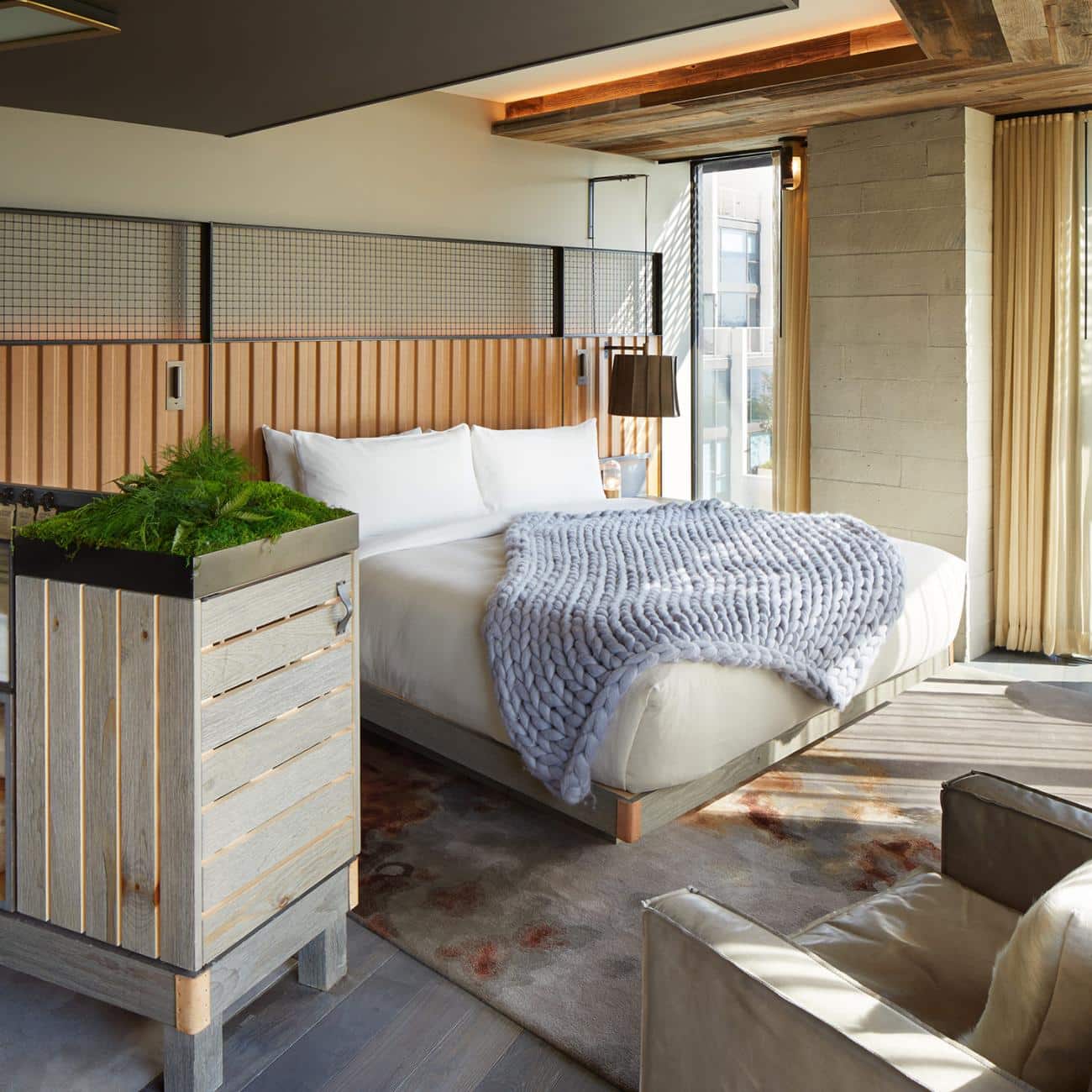
Often people believe that investing in sustainability for a hotel will come at the cost of beauty and amenities, but the 1 Hotel chain has proven this to be utterly false. Barry Sternlicht, CEO and Chairman of 1 Hotels, is attacking sustainability as a design problem. In regards to their design, Sternlicht says “I wanted to capture the beauty of nature in a hotel and commit to safeguarding it as best I can, a responsibility that I believe we all share. It’s 1 world.” With help from partners like the Leonardo Dicaprio Foundation and Oceanic Global, 1 Hotel’s has injected eco-consciousness throughout its hotels and offices. Each hotel is packed with living plants and many of the buildings’ materials are recycled such as wooden chalkboards found in guest rooms. The company has dedicated full workdays to volunteering and advocating for environmental causes. And 1 Hotel’s is also committed to reducing their footprint by initiating a plastic waste reduction program and using greener products in their guest rooms such as organic sheets. 1 Hotel’s is doing a superb job at providing the example that a hotel does not need to lose its image and its beauty in order to make choices that are better for the environment and their visitors.
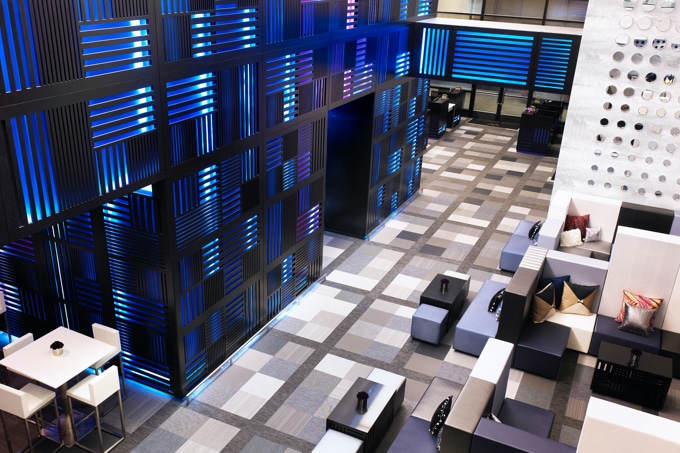
Companies like Marriott have the largest opportunity to set the standards on sustainability for the hospitality industry due to their brand recognition and wide-spread customer base. They understand this and have initiated their corporate social responsibility campaign, Serve360, in order to work toward their sustainability goals by 2025. Marriot has set applause-worthy goals in the areas of reducing environmental harm, building and operating sustainable hotels and sourcing sustainable materials in their supply chain. The company has already phased out all plastic straws and stirrers across all of its locations globally! They also provide electric vehicle charging stations as a complimentary service as most of their locations, enabling eco-conscious travelers to stay with them easily. All of their goals and metrics on impact to date are available on their website. Their commitment to environmental sustainability and their transparency of reporting their impact should serve as an example for other hotel chains who have not yet thought about how these decisions can impact their profitability in the long term.
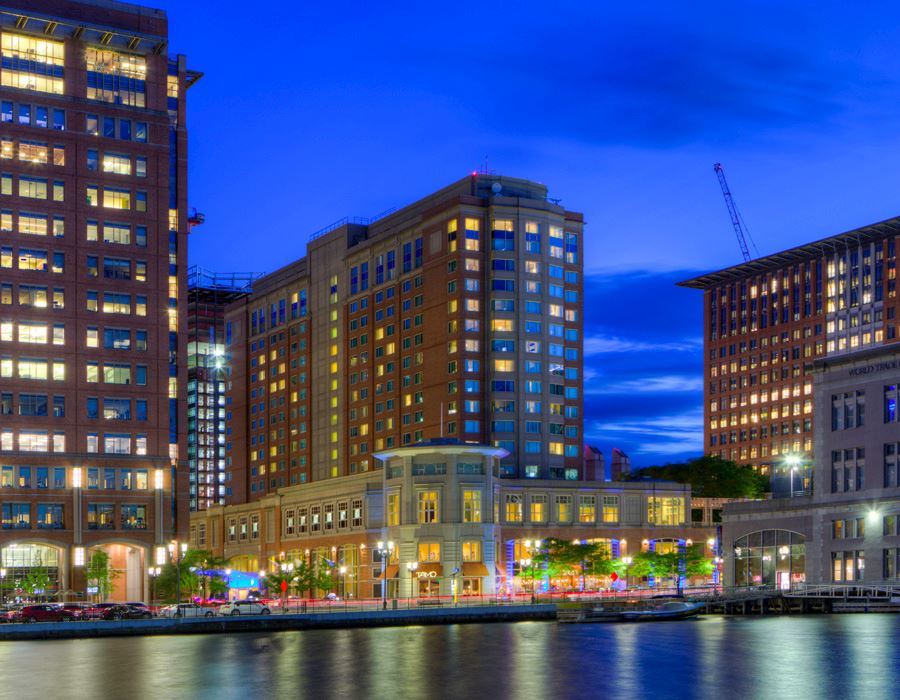
Sustainable decisions not only need to be made in the hotel locations and guest rooms of these businesses but also behind the scenes in the company headquarters and other offices. The Seaport Hotel in Boston, known as one of “America’s greenest hotels” has tackled this issue by providing employees with a solution to replace single-use plastic water bottles and seltzer cans that were generating a huge amount of waste. William Hacking, Director of Food & Beverage for the hotel, was originally looking for a way to influence healthier eating and drinking habits of Seaport Hotel employees when he found Bevi. This smart water dispenser drives workers to drink more water during the day because of the joy that comes with completely customizing your delicious beverage. Not only that but Hacking stated, “Before the Bevi machine was installed, 70% of the employees were drinking soda with their meals. Now, with the Bevi machine, more people are getting unsweetened, flavored sparkling water instead, and soda consumption has dropped to 10%.” With increased hydration comes increased productivity and alertness, and a happy workforce is a successful one. Not only has the water dispenser helped with Hacking’s goals to foster a more health-conscious workforce, but it has helped Seaport Hotel’s hold onto their “America’s greenest hotel” accolade.
In a 2018 Global Luxury Travel Insight study, Fairmont Hotels & Resorts learned that 80% of travelers are looking for hotels that provide “experiences that are not detrimental to the local community” and that a majority of those travelers also want their hotel to implement “environmentally sustainable practices”. The Fairmont hotels are very popular amongst luxury business travelers and as more millennials enter this bracket, their need for sustainable hospitality solutions as a group increases. At their St. Andrews Bay hotel, this company has decided to replace the disposable plastic water given to visitors with “specially designed refillable water bottles”. Hotels can make travel easier for business clients by providing them with convenient refilling stations throughout their locations. Here is a list of the 5 best reusable workplace water bottles that the environmentally-minded business traveler is using these days.
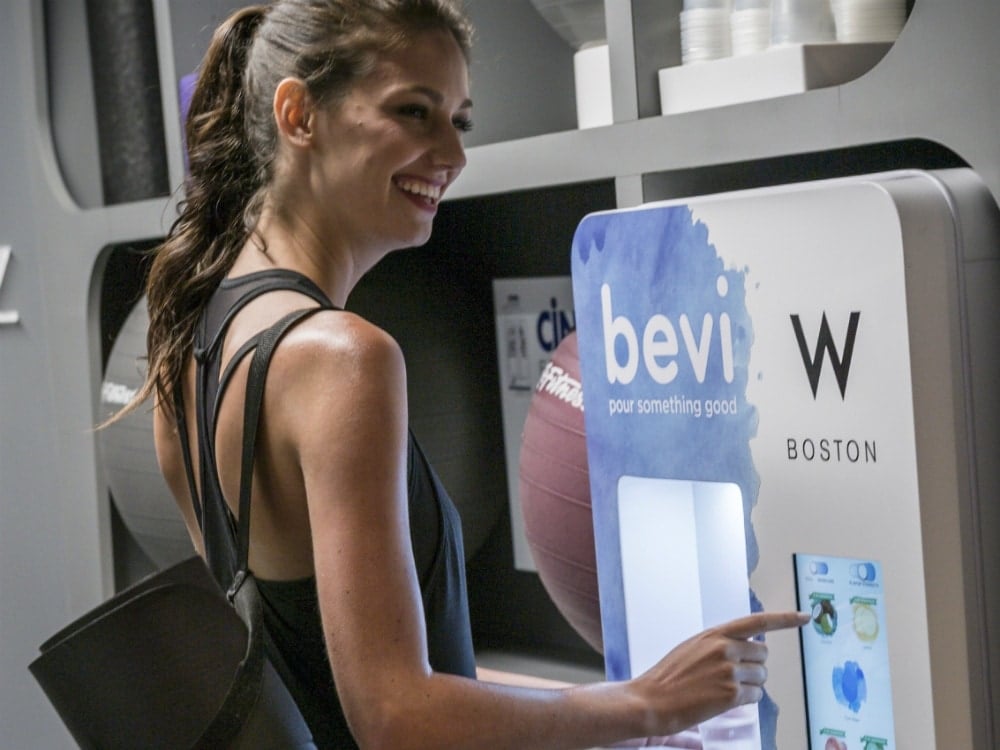
Whether you are a global conglomerate tackling long-term sustainability goals inline with the UN Sustainable Development Goals like Marriot, designing your hotels for mindfulness and eco-consciousness like 1 Hotel’s, or simply trying to make everyday operations greener like the Seaport Hotel, there are so many changes the hospitality industry can make in order to do less harm to the environment, invite new customers in without losing the old, and benefit the bottom line in the long run. Check out these articles to see what other hospitality companies are doing to meet their sustainability goals:
One last thing! If you work for a hotel or have the ability to share Bevi with someone who does, please refer them through our website at https://bevi.co/referral-bevi
It’s no secret: as an office manager and administrative assistant, you play a critical role in your office. From ensuring employees have the resources and supplies they need, to scheduling interviews, meetings, and celebrations, you are the gears (and the grease!) that keep day-to-day operations running smoothly. When you’re set up for success, the entire organization will thrive.
Help you and your organization flourish in 2020, and check out these must-attend conferences for office managers in 2020. Explore the latest business trends, learn operational and organizational strategies, and hone your administrative skills in the company of experienced admin pros.
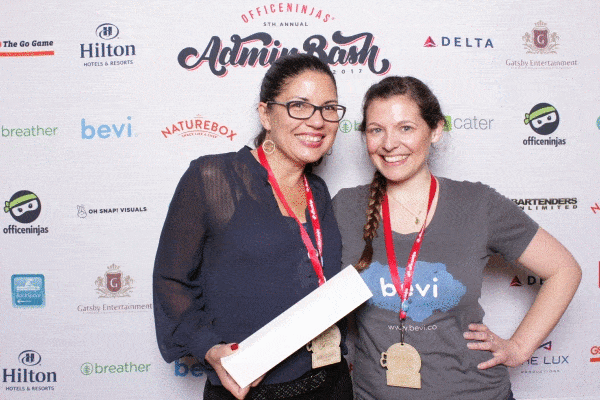
Update: Admin Week will be in fall 2020 as a highly immersive virtual conference. For more information on tickets please click here
Admin Bash
Admingling
This spring, join OfficeNinjas and admins from across the globe in celebrating ‘The Era of the Office Ninja.’ Back in full force with online flash raffles, giveaways, and awards, OfficeNinjas’s Admin Week will run from April 20-24.
For those able to make it to San Francisco, grab a ticket (sooner rather than later, they typically sell out) for Office Ninja Con, a two-day adventure jam-packed with interactive instruction, thought-provoking discussions, and practical exercises. Make connections with admin pros from across the globe, learn about game-changing products and services, and plunge head-first into actionable best practices for everyday success as an admin.
On the night of April 22, Office Ninjas Con ends with the ultimate admin party: Admin Bash. With budget-friendly tickets, Admin Bash ensures Ninjas from all over have the opportunity to get the gratitude they deserve. So grow your network, indulge in tasty treats, and leave with a legendary swag bag: Admin Bash is your party!
Can’t make the trek to San Francisco? Explore OfficeNinjas’ line-up of Admingling events (smaller, after-work events that blend networking, hands-on activities, and partying) here to meet up with all-star ninjas in a city near you.
And don’t forget to subscribe to OfficeNinjas’ newsletter or follow them on social media to enter all of their Admin Week flash raffles and participate in the digital celebration!

Get ready for a whirlwind of speakers, workshops, and effective, no-fluff strategies to transform your workplace.
In July of 2020, founders, culture champions, HR professionals and admins will gather at Culture Summit with a collective goal in mind: build the culture you want to work in.
With cross-functional, cross-industry speakers from renowned brands such as Twitter, Stitch Fix, and Patagonia, this three-day summit in San Francisco is not meant to sell you perks. Instead, you’ll leave with the tools, data, and frameworks to reframe and revamp your workplace culture.

Known for their extensive resources and active online network of admins, OrgOrg is gearing up for their second-ever conference, Camp OrgOrg.
This one-day conference is specifically designed for ‘Organization Organizers,’ or the people behind the scenes, like you, that make sure everything at work works. With a diverse line-up of panels, workshops, breakout discussions, and social activities, Camp OrgOrg empowers attendees to develop their skills, harness their creativity, and leverage their peers in order to do their best work at work.
In an effort to make Camp OrgOrg as accessible as possible, the organizers offer scholarships and discounts for those in need. And if you simply can’t make it to San Francisco this May, be sure to join their online community of office managers, executive and administrative assistants, people ops pros, and HR professionals. Gain exclusive access to resources, groups, and event announcements, and chat with like-minded peers from around the country.
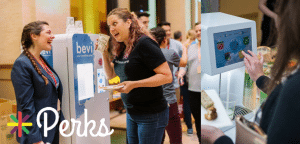
Update:
The Perks Convention is more than just flashy products and Employee Appreciation Day inspiration: it’s an employee experience expo. With 100+ vendors, interactive lounges, and curated workshops, Perks Convention strives to connect office managers with relevant, research-backed, and affordable solutions for all kinds of organizations.
Better yet, it might be hosted right in your backyard! With six conventions in major cities across the US planned for 2020, Perks provides the opportunity to share stories and network with office managers from your region. Keep an eye out for their giveaways, health and wellness initiative ideas, and of course, groundbreaking perk ideas for your office.

With over two thousand attendees at last year’s conference, the Administrative Professionals Conference raises the bar for dynamic, professional development for administrative professionals and executive assistants.
The conference focuses on ‘real world’ admin education, offering 75+ training sessions that participants can pick and choose from according to their specific needs and goals. Boost your communication skills, learn new technologies, or refresh your finance knowledge: the choice is yours! The conference’s primary goal? Help you recognize your brilliance.
Beyond its extensive list of training sessions, the conference also includes a diverse line-up of keynote speakers that will tackle creative approaches to productivity, organization, and leadership. Achieve your professional goals, and be inspired at the Administrative Professionals Conference happening this September in Las Vegas.
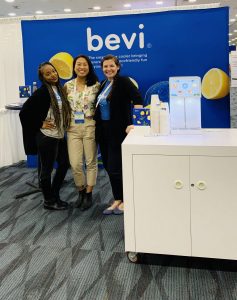
Join IAAP this year in sunny Orlando, Florida for their annual four-day summit. A morning until night immersive experience, the IAAP Summit creates space for all types of learning. Attend a deep dive education workshop with an industry expert, connect and learn from peers during an informal lunch, participate in interactive, think-tank style challenges with a group: everyone grows in their own way.
Registration also includes a first-time attendee orientation, cocktail reception, and awards gala, personalized consultations at the wellness bar, a marketplace expo of innovative vendors, and a closing keynote by Ted Ma. Get ready to brush up on your skills and renew your passion for administrative work at the 2020 IAAP Summit.

Catapult your career into the future of administrative excellence at The Conference for Administrative Executives happening this fall in Las Vegas, Nevada.
This year, the conference will take a journey to ‘2020 and Beyond,’ providing a suite of classes, talks, and company spotlights to help participants cultivate the necessary skills and perspective to excel in the administrative landscapes of tomorrow. From global perspectives to digital IQ deep dives, themed galas to a successful store of career-enhancing products, The Conference for Administrative Executives is the right blend of work and play to keep you engaged.
Invest in your career and your future: register today!
—
These conferences, summits, conventions are more than just educational experiences: they’re opportunities to connect with a national, sometimes global, community of passionate administrators like you. They’re also a great way to check out innovative vendors changing the face of the modern workplace; be sure to stop by the Bevi booth to learn how you can bring customized beverages to your office!
Mark your calendar, get ready to pitch your boss, and don’t miss out on these seven must-attend conferences for office managers and administrative professionals in 2020.

Often times, the Office Manager is on the front lines of a continuous battle between those employees who value convenience and those who prioritize environmental impact. From balancing the office’s budget to fielding all types of employee complaints, the Office Manager is almost always stuck between a rock and a hard place.
As with any daunting task, it’s best to start small. And implementing a Bring Your Own Reusable Bottle initiative is a great place to start.
Rather than stocking and restocking sky-scrapers of plastic cups in your kitchen, reduce your plastic waste exponentially by encouraging employees to take their favorite canteen into work with them. This BYOB approach will not only save the Office Manager time, but save money — money that can be reinvested in something everyone in the office will love, like fruit or snacks!
Don’t left the office kitchen battles continue: check out these 5 tactful ways to get everyone on board — and even excited about — the new BYOB initiative.

Remember: there’s strength in numbers.
Whether you’re an Office Manager or an environmentally-conscious employee, it’s best to have a team of people behind you when proposing a new and drastic change to life at the office.
Don’t face the rebuttals and complaints alone. Gather a squad, inform them of the change and its rationale, and let the company know that there’s a whole group of excited employees ready to answer any questions that may come up.
Especially at larger companies, where it’s unlikely everyone knows each other on a first name basis, try to involve a few people from each department in your sustainability task force. Employees are more likely to trust and support the people they work with everyday than a faceless email announcement from someone they’ve never met.
Before kicking-off your BYOB program, be sure to form a squad of people who can help hype up its positive, environmental impact, as well as field any comments or concerns different departments may have.
Is this your recycling bin? Looks like it’s time to get Bevi.
For some offices, getting rid of plastic cups might be as simple as never buying them again. In other offices, however, the transition might not be as smooth. If you’re worried about an impromptu employee mutiny, there are several ways to ease your office into a more zero-waste approach to water cooler talk.
After launching your BYOB program, try leaving only a small stack of plastic cups in plain sight. Chances are, many folks won’t go looking — or won’t know where to look — when the stack disappears. This will help to incentivize people to bring in their bottles, since having to find and restock the plastic cups is more effort than carrying your own bottle. You might get some annoyed comments about the lack of cups over Slack, but stay strong! Tell these folks where they can find more cups, but don’t restock them yourself.
If your office isn’t equipped with reusable glassware, keeping an emergency pack of single-use cups on hand is kind of a must — especially if you frequently have visitors. In this case, stash the solo cups away in a secret cabinet or drawer, and reveal them only when you’re expecting guests.
In general, if the BYOB initiative is more controversial than you planned, relieve separation anxiety by making the transition from plastic cups as gradual and reasonable as possible.

If you’ve got the budget, this is a no brainer.
What better way to launch your BYOB initiative than to purchase a personalized or company-branded (or both!) reusable bottle for each of your employees.
Many companies that are both getting a Bevi and moving into a completely new office space like to include reusable bottles as part of a ‘Welcome to Your New Office’ gift for each employee. Broadly speaking, moving into a new space is the perfect occasion to put new, eco-friendly systems in place!
While not every office has the funds to purchase bottles for everyone, there are many work-arounds. Water proof stickers are a simple and affordable way to get employees hyped about showing off their newly decorated reusable bottle around the office. Have your designers create a whole series of stickers to pick and choose from, or get everyone a decal of their name. Another solution is to work with your team to select and design a bottle that people can order on their own if they so choose — this works well in offices in which most people already have a favorite bottle, and may not need the company topurchase one for them.
Once your custom bottles arrive, encourage folks to leave them at work. With shiny, new reusable bottles on their desks, the die-hard plastic cup users will surely become BYOB champions.
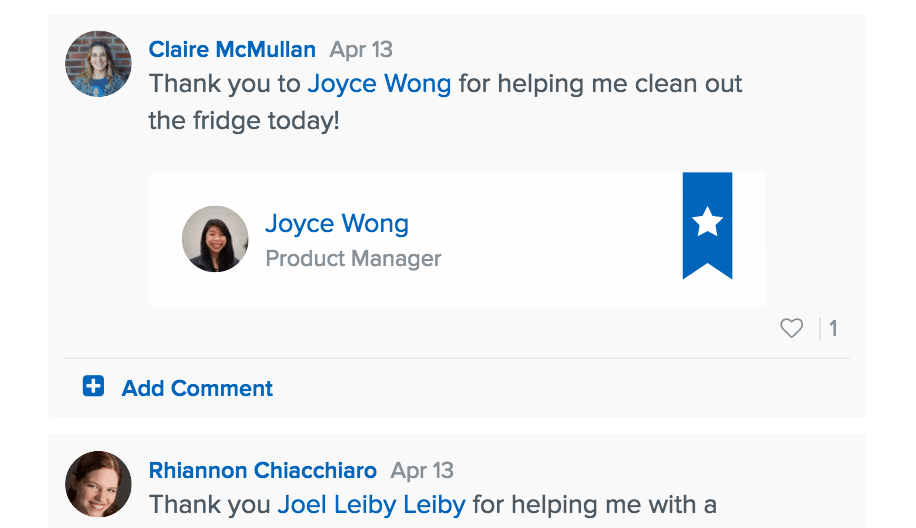
At Bevi, we love giving shoutouts over Slack or in our HR portal, Namely.
Ever heard of intermittent reinforcement conditioning? If you haven’t, all you need to know is this: it works! As foreign as this term may sound, chances are it’s something you’re already doing in the office. Each time you randomly give a shoutout to an employee over Slack, you are using the power of intermittent conditioning to motivate and reinforce positive behaviors!
The true beauty of intermittent conditioning lies in the fact that you only have to reward behaviors occasionally in order to reinforce them. In knowing that they might get recognition for their positive behavior, employees will start to make good habits part of their normal routine, whether it’s helping to clean out the fridge or bringing their reusable bottle into work.
Don’t take this the wrong way: we’re not suggesting you treat your co-workers like Pavlov’s dogs!
All we’re saying is that highlighting or rewarding someone who has brought their reusable bottle into work is a really great way to motivate that individual — and others — to keep your BYOB initiative going strong.

A toast, to all those who use a reusable bottle. Cheers!
Similar to Green Strategy #4, keep your BYOB program top-of-mind by frequently sharing how it has positively impacted your office and beyond.
In addition to a company-wide email or appreciation post, go big and briefly share results in the next All Hands meeting. If eliminating plastic cups has saved you enough money to buy more snacks for your office, put a sign on the fridge or water cooler explaining how the new treats are the fruits of your office’s collective labor!
For companies that have an explicitly environmental mission, your newly instated BYOB initiative could be a great occasion to brag about your company’s awesomeness on social media. Some companies might even opt to highlight an eco-warrior of the month; in other words, give a shoutout to an employee that has gone above and beyond when it comes to keeping things green at work.
Whether you’re a small startup or an international corporation, a Bring Your Own Reusable Bottle initiative is a simple and effective way to reduce your office’s footprint.
Not all company growth requires a brand new office; often times, a few adjustments to the current office layout can make a big impact, ultimately helping your space become both more productive as well as accommodating of future growth.
For quickly growing startups like Bevi, each round of hiring presents a challenge to the delicate balance of the current floor plan. Teams begin to outgrow their original areas, and suddenly 7 people are sitting in a space that was designed for 2. And since many startups have an accelerated hiring timeline, this puts a lot of pressure on Office Managers, HR, or Facilities Managers to change the office layout quickly and seamlessly. No matter what the occasion, rearranging an office space can be stressful — especially when current employees are not 100% on board.
We’ve got your back. We interviewed our own all-star Office Manager, Claire, to put together this list of 11 things to do before, during, and after a change to the office layout. We can’t promise that the office won’t mutiny, but at least you’ll have a contingency plan if they do (see #3 for some of Claire’s tips).

Regardless of your company’s size, getting key stakeholders on board is the first step towards getting the entire office to buy into the changes. Key stakeholders are more likely to recognize how space adjustments will benefit the company as a whole and can communicate this directly with their respective teams. Especially if you work for a larger company and don’t know everyone by name, employees are more likely to cooperate with someone they know and trust.
Another strategy for getting each team excited about the change-up is to actively incorporate their goals and needs into the new office schematic. Whether informally in the hallway or at an all-hands meeting, check in with each team to see what they like about their current format and what they would change. By proactively discussing their needs and concerns, you are helping deflect any dissent in the long term.
No matter how much you plan, there will always be something to work out after the rearranging is done. For this reason, it’s good to establish a trial period, so that in one or two weeks time you can reassess whether the new layout is working out.

Source: Pixabay
During the trial period, have your employees send feedback to a designated Slack channel or survey. This way, folks have a space to express their concerns and you have the ability to mute their reactions until the trial period comes to a close.
If you’re really getting bombarded with comments or requests, ask your own manager to openly address (and shut down) any opposition. It’s always nice to have someone on your side to help deflect any whining — it really gets old after awhile.

Source: Pixabay
If you have the opportunity to make a change, think big! Chances are there are several open positions at your company, so think about how your desks will be populated once new employees arrive. Consider syncing-up with HR or senior management to find out the teams the company is looking to expand over the next quarter (or year) so you minimize the amount of times you’ll have to reorganize the office.

Source: Unsplash
Whether they’re investors or user testing groups, visitors expect to see people hard at work upon entering your office. Put your company’s best foot forward by making sure the teams closest to your front door (or visitor entrance, if you have a larger company) are typically in the office.
Here at Bevi HQ, we have a stellar hardware team that spends a good portion of their time in our engineering lab a few floors down. Our Office Manager Claire had the foresight to situate the hardware team in the back corner of our office, so our visitors would never be greeted by empty desks.
Similar to #2 and #3, constant communication is key. Between Slack messages and email updates, be sure to remind your employees to pack up their belongs 1 week and 1 day before the move as well as on the day of.
Once the layout has been changed, it’s a good idea to send an early morning reminder with the new seating chart and instructions on how to inquire about any missing belongings. Our Office Manager Claire made sure everyone stayed in the loop by giving email and in-person reminders in the days leading up to the reshuffling.
X marks the spot. Before moving anything in your office, sketch out a few options for a new office set-up. Pro-tip: always make sure they are to scale!
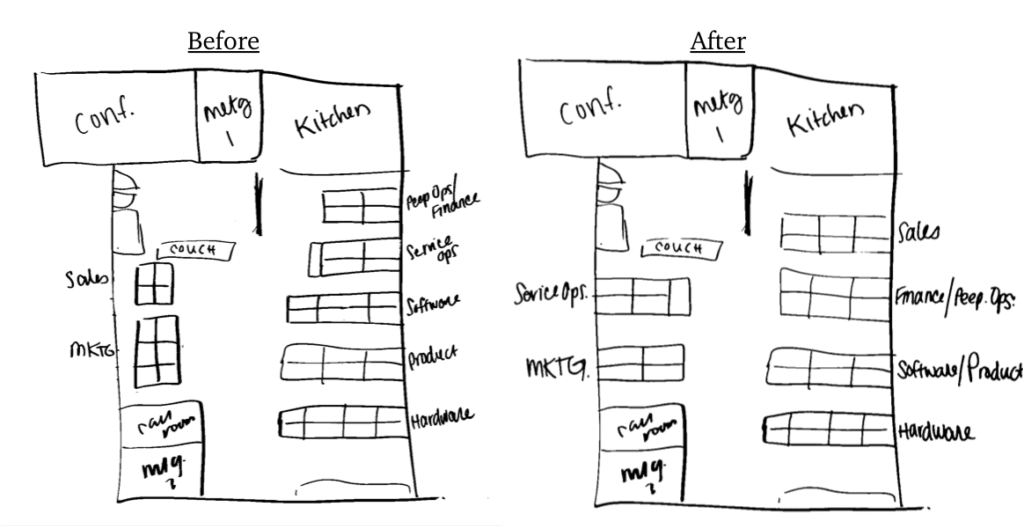
Office Manager Claire breaks down Bevi HQ’s most recent layout change.
If you consider yourself visually or spatially inept, ask a designer or engineer to help you realize your vision. They might even have some handy software that can help make testing different layouts much more efficient than using a ruler and graphing paper. For example, Eliza, one of Bevi’s co-founders, helped Claire model different versions of the office without moving a single desk.
While you will need an extra set of hands to make the rearrangement happen, less is more when it comes to having people in the office during all of the shuffling.
Aside from staying late on an arbitrary weekday, the day before a long weekend or holiday is often the perfect time to make your move. Back in November, our superstar Office Manager Claire planned to change things around in the office on the day before Thanksgiving. It worked out well as there were a few folks in the office to lend a hand and enough room to reposition the furniture without disturbing anyone. Within a few hours, everything was readjusted and ready for the new hires starting the following Tuesday — myself included!
Plus, let’s be honest: when the majority of people are out of the office, those who do come into work often look for fun side projects to work on. These people are your biggest asset on the day of the move.

Source: StockSnap.io
A new layout often means new furniture. But don’t be fooled: you’re going to need a screwdriver and hammer before your furniture looks as shiny and perfect as it did on Ikea’s website.
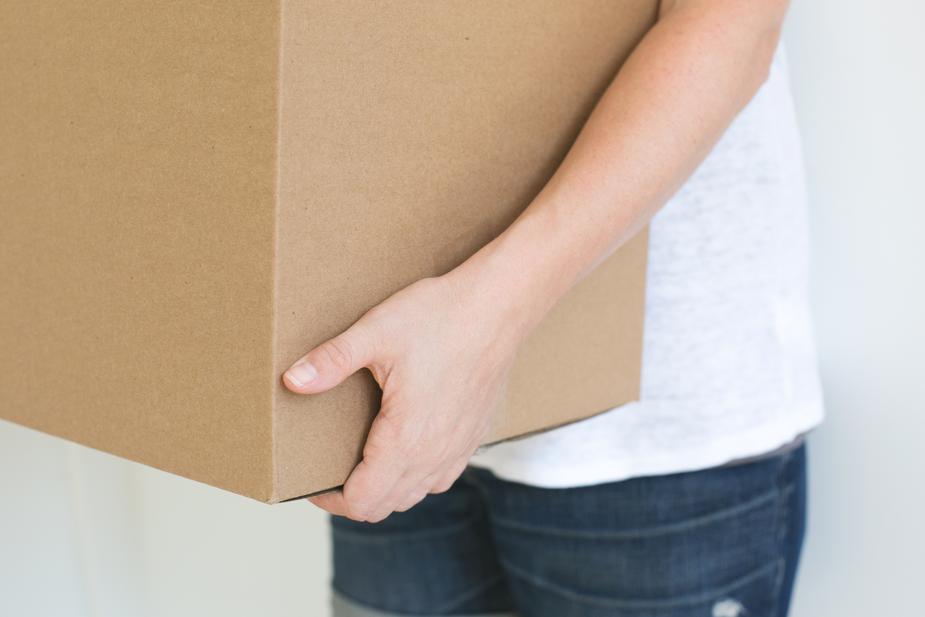
Source: Burst
Even the office hero needs a little help once in a while. Rather than trying to rough it by yourself, enlist a few helpers to move or assemble desks and chairs while you double check the diagram of the new set-up. For medium-sized or large companies, you’re better off hiring movers to help you get the job done quickly and efficiently.
With just over 30 people working in Bevi HQ, the office is certainly on the smaller side. Nevertheless, a few things did get lost in our most recent round of office rearrangements. Take it from us: labeling is everything.
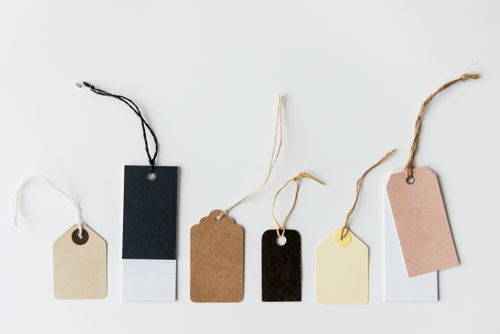
Source: StockSnap.io
Whether with masking tape, printed labels, sharpies, or cute cat stickers, make sure everyone clearly labels the box containing their belongings before anything gets touched. You’ll thank yourself later.
Looking for more ways to keep your office happy and healthy? Meet Bevi, the smart water cooler designed to make your life as office manager that much easier.
Request a free flavor tasting for your office here.
Each year, Americans toss out more than 4 million tons of wrapping paper. Bring tidings and good cheer to the Earth this holiday season with these 8 eco-friendly alternatives to gift wrap.
And the Grinch, with his grinch-feet ice-cold in the snow,
Stood puzzling and puzzling: ‘How could it be so?
It came without ribbons! It came without tags!
It came without packages, boxes or bags!
— How The Grinch Stole Christmas by Dr. Seuss
In a world in which $2.6 billion dollars is spent annually on one-time use wrapping paper, the Grinch’s famous cry of disbelief reads like an eco-advocate’s exclamation of joy.
It’s no surprise that Americans produce 25% more waste in the weeks between Thanksgiving and New Years than in any other period of the year. Every holiday season, Americans throw out over 38,000 miles of ribbon, not to mention the 15 million Christmas trees that get tossed in the trash.
It’s the most wonderful — and wasteful — time of the year.
Although these stats may make you want to say “bah humbug,” using alternatives to wrapping paper is an easy way to reduce waste this holiday season. Check out these 8 eco-friendly ideas.
Good things come without a package. There are all sorts of ways to use a gift as its own packaging; some ideas include: wrapping mittens and socks in a matching sweater, filling a pot or pan with kitchen supplies for someone who just got a new apartment, adding gardening supplies to a bucket or plant pot, stuffing a new purse with gift-cards, wrapping a gift box in a scarf or cozy blanket, making a mini care-package for a college student in a Tupperware container, etc. Let’s face it, you’re a gift giving pro, and don’t need any help from paper packaging to prove it!
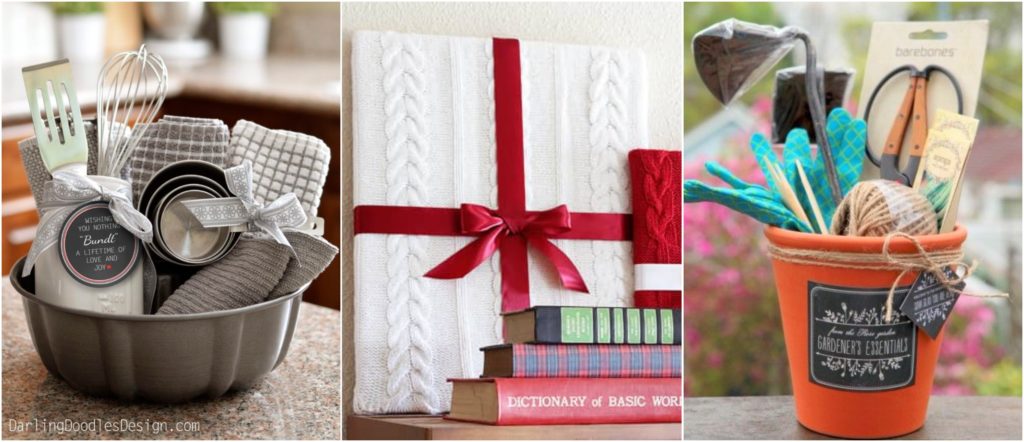
Sources: DarlingDoodlesDesign, A Part of Life Blog, and Garden Therapy.
Good for gifts of any size, and perfect for those who actually enjoy perfectly folding and taping each individual gift. While the newspaper will end up in the recycling bin along with the regular wrapping paper, at least it was repurposed. If you like the look of paper gift wrap, but would like to cut back on your tape usage, try doing some wrapping paper origami or using ribbon instead of tape (see #6 for an upcycled ribbon idea).

You’ve been pregraming for Great Aunt Susie’s annual holiday party all day when you realize you forgot to wrap your Secret Santa gift. Have no fear: the 6-pack box you were about to throw out will do the trick! 6-pack boxes are perfect for multi-component (or multi-person gifts). Similar to good old-fashion stocking-stuffing, you can stuff each of the six compartments with gift items. Things like socks, rolled-up t-shirts, hair care or skin products, chocolate bars, candles, and of course, beer, fit perfectly in each slot. (Not a beer drinker? Check out these 6-pack boxes with built-in holiday cards made by Beer Greetings.)
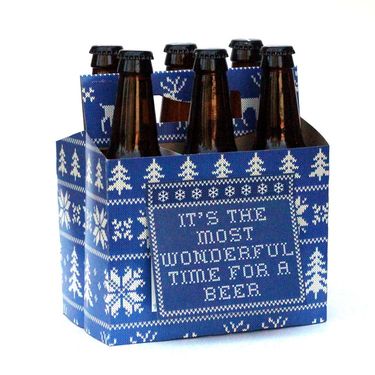
Source: Beer Greetings
Chances are you have about 3 cereal or snack boxes sitting in your recycling bin right now. There’s nothing better than adding multiple layers of surprise: using cereal and snack boxes of different sizes, try packaging up a small gift in a series of boxes — sort of a Russian nesting doll approach. This is a particularly good way to make opening gift cards a little more fun for kids.
In the golden age of smart devices, printed maps are nothing but dust collectors. Rather than keeping that map of Virginia in your glove compartment as an artifact of decades past, consider upcycling it and using it as a substitute for traditional paper gift wrap.

Put those old little league t-shirts to good use by transforming them into ribbon. While this upcycled gift wrap idea may require a little more work and planning on your end, the process is very simple. All you need is an old, colorful t-shirt and a pair of scissors. Check out this quick how-to video for instructions, and say goodbye to twirling ribbon.

Source: Instructables
I’m sure everyone has seen mason jars with cookie and cake mix in in local specialty shops. Mason jars are very versatile, and are the perfect vessel for any type of recipe, from a cocktail starter kit to a ‘spa-in-a-jar,’ to sewing kits and ‘go fishing’ jars. If you’re at a loss for gift grab ideas, thinking about what would fit into an empty mason jar is an easy way to jump start your brainstorming process.
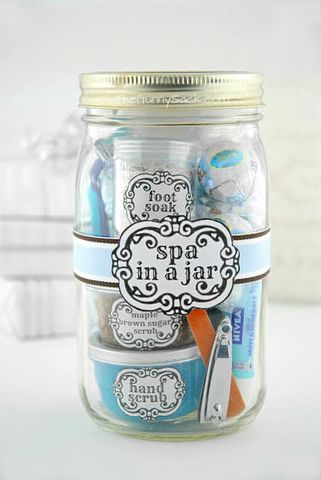
Source: The Gunny Sack
So you have a box, but you don’t have any maps, newspapers, tape, old t-shirts…or any time. You’re not as short handed as you think! Instead of writing a card, use the box as your canvas. Write funny quotes or memories about the gift recipient; jot down a riddle; say something witty about why gift wrap is a thing of the past. When I was a kid, my mom let us decorate the outsides of the boxes we were shipping to family members out of state. Using stamps and paint, the once dreary brown color became a sea of colorful patterns and shapes.
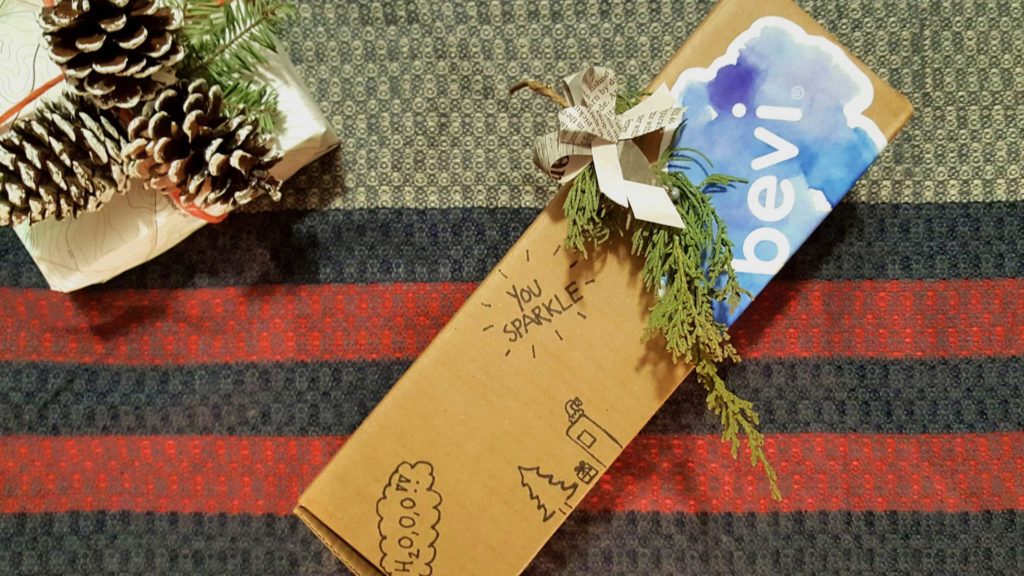
We added a Bevi sticker to ours
In addition to these alternatives, there are also several reusable fabric gift wraps out there for purchase (check out LilyWrap or the variety of options available on Etsy).
Regardless of the approach you take, there’s no better way to show someone you care this holiday season than using sustainable gift wrap.
When we’re not promoting eco-friendly gift wrap, Bevi is on a mission to reduce plastic bottle waste, one pour of sparkling grapefruit water at a time.
Learn how you can reduce your plastic bottle waste here.